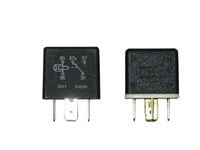The headlight relay on my 2008 Triumph failed the other day, which didn’t really bother me; hey, it happens right? Unfortunately, my friendly neighborhood Triumph shop didn’t have any replacements in stock, and weren’t expecting any for at least another week. Not wanting to wait that long, I trotted down to the local auto parts store and tossed the old one at the counter rat. “Got one of these? “Yeah I do” he said. After the banter I installed my new relay, the lights came on and I was a happy camper. Granted, not all OEM relays are so easily replaced by generic counterparts, but it’s always worth a shot—all you have to know is what relay to use and figuring that out is easy.
While there may be exceptions, relays normally have all nomenclature printed right on them. First, look for the OEM relay manufacturer’s part number; it should be imprinted somewhere on the relay case. If you have that, you can source the identical relay from your local auto parts store or cross-reference it to something generic from an aftermarket supplier like Echlin/NAPA without much effort.
No number? No problem. While it’s not a hard and fast rule, most relays will also have a wiring diagram showing their internal circuit configuration printed on the side; among other things, the drawing will show you whether the relay is normally open or closed and which pin feeds which circuit.
Likewise, the relay pins are always numbered and yes, that coding follows the universal DIN format, so terminal #30 is always battery-fed current, and terminal 85 is always grounded. Knowing that, you can just match up the number and configuration of the terminals, compare the circuit diagram, and assuming everything matches, you’ll be good to go.
Like I said, not all relays will be available, but in most cases, finding something common like a headlight or starter relay shouldn’t be that difficult.

/cloudfront-us-east-1.images.arcpublishing.com/octane/VUOTFUMRZBFILJ4TBSKYNRPZDM.jpg)
/cloudfront-us-east-1.images.arcpublishing.com/octane/A2TMJNBKPBEQJEF6PB2Q5PGQHM.jpg)
/cloudfront-us-east-1.images.arcpublishing.com/octane/C3WGBZCFABC7XKBCFCCXDWYWME.jpg)
/cloudfront-us-east-1.images.arcpublishing.com/octane/CCPZFYVVRBF2DLPMDYKPF4TMME.jpg)
/cloudfront-us-east-1.images.arcpublishing.com/octane/4QSMPPK4X5HE5D7QUFJLYC6GLY.jpg)
/cloudfront-us-east-1.images.arcpublishing.com/octane/7EG6FR6QOJGR7FFROLIPDUVTVM.jpg)
/cloudfront-us-east-1.images.arcpublishing.com/octane/QC73NNGYHZDWTNVTLNABEDJJ2Y.jpg)
/cloudfront-us-east-1.images.arcpublishing.com/octane/THUUBJNOAFCNHGFM34RRWJGVX4.jpg)
/cloudfront-us-east-1.images.arcpublishing.com/octane/UGMQGLINLRBVHC6U6Y4HJHQ3RY.jpg)
/cloudfront-us-east-1.images.arcpublishing.com/octane/ENCTP2GIJ5DFVH2QPFJRFJ3IDI.jpg)
/cloudfront-us-east-1.images.arcpublishing.com/octane/2W2YYLKRUJHW5CQOQSZPOVNHI4.jpg)
/cloudfront-us-east-1.images.arcpublishing.com/octane/ULSZOOV3GRGHLFYHABDDYIHJT4.jpg)
/cloudfront-us-east-1.images.arcpublishing.com/octane/52GPADYLYZFEDJ6WKHNF44PYNU.jpg)
/cloudfront-us-east-1.images.arcpublishing.com/octane/SWMZI3VS7NANXHECY5KVQO47BE.jpg)
/cloudfront-us-east-1.images.arcpublishing.com/octane/6F5UZMOWJFDRXDHN66HSW7725E.jpg)
/cloudfront-us-east-1.images.arcpublishing.com/octane/SNQEMPXRCBDKPCXJIN24D4J22M.jpg)
/cloudfront-us-east-1.images.arcpublishing.com/octane/GXHESE63GNGPLEOJ2JJANNGQ5Q.jpg)
/cloudfront-us-east-1.images.arcpublishing.com/octane/3USOOXJEHJB6NB2NNKU73HMRVY.jpg)
/cloudfront-us-east-1.images.arcpublishing.com/octane/6GLBGD7S75B7JP2GRYNEJO4TBE.jpg)
/cloudfront-us-east-1.images.arcpublishing.com/octane/SCA4CUE6YBHGRHKU7HEG3YHWGQ.jpg)
/cloudfront-us-east-1.images.arcpublishing.com/octane/LICXFHEM45CJZNVP6K36OVJSYQ.jpg)
/cloudfront-us-east-1.images.arcpublishing.com/octane/AJKZ2F5GIZEZREL5JQTKYYJ54E.jpg)
/cloudfront-us-east-1.images.arcpublishing.com/octane/R6QOQ7QOEJBVXP6CXT3R2LABII.jpg)
/cloudfront-us-east-1.images.arcpublishing.com/octane/KLI2FNJIQFEZVDXOAGYNOIN5HA.jpg)